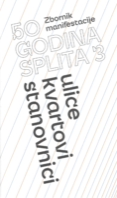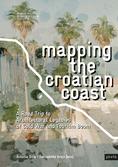local development demography tools and techniques Community strategic planning urban market design social exclusion/integration digitalization urban renewal Cohesion urban theory educational identity urban form land use rigenerazione urbana neighborhood planning Communication giornata di studi inu smart city economics cities urban africa
50 Years of Split 3
Streets, neighbourhoods, residents
Višnja Kukoč and Jelena Borota (eds.)
The Book of Proceedings collects and reconstructs the origin, content, and format of the diverse program of the event 50 years of Split 3 – streets, neighbourhoods, residents. The heterogeneous format (an exhibition, a round table, urban promenades, an open-air concert, and lectures) attempted to bring the complex field of urbanism as close as possible to students, architects, urban planners and also citizens.
Split 3 (340 hectares for 50 000 inhabitants with all the necessary amenities) strongly marked a fruitful period of urban planning and realisations in Yugoslavia. Already during construction, it attracted the attention of domestic and international experts such as Giancarlo De Carlo, Jane Jacobs and others.
This Book gives a contribution to the Split 3 theme, an extremely rare example of town-building, unfortunately still not adequately covered in architecture and urbanism publications, with the hope of widening the audience interested in Split 3 and giving the necessary impulse for further research.
The Book of Proceedings of the event displays all its components including the articles of the lecturers who were free to express themselves as they wished, regarding form and length.

50 years of Split 3 | V. Kukoč and J. Borota (2021) | Map - Photo by Lea Jurčić
Besides the articles, the value of the book lies in a series of reproductions of the originals ranging from plans and urban projects to architecture projects, sketches as well as architecture details. For the first time, a map of Split 3 is reproduced. It includes a list of all the streets in Split 3 and their authors. It provides a complete list of architects and urbanists involved in the endeavour of making the city’s third rayon, as well as a thorough list of public buildings, business buildings and university campus buildings. The map can be used as a separate gadget (a guide for architecture tourists) as well as a tool for reading the book.
The book includes a series of texts directly related to the creation of Split 3, the context in which it came to be, and the possibilities of its urban revitalization at present. Some of the lectures turned into texts were given by direct participants of the city making process: Ante Mihanović, exceptionally skilled constructor, innovator, and professor emeritus, Jakša Miličić, the mayor of Split from 1967 to 1974 who also served several times as the dean of Faculty of Civil Engineering, Architecture and Geodesy, and Ante Svarčić, a renowned architect of the most important Split 3 street called Sveučilišna ulica.
Other lectures were made by distinguished scholars that we list here in alphabetical order: Bruce Appleyard, urban theorist, teaches urbanism at San Diego State University, Ivan Basic, historian, teaches history at Faculty of Philosophy in Split, Ljiljana Blagojević, architect and architecture theoretician of international acclaim, Leonardo Ciacci, urban theorist specialized in filmed communication of urban projects, Janez Koželj, urban planner, deputy mayor of Ljubljana, Ivan Mlinar, urban planner, teaches urbanism at the Faculty of Architecture in Zagreb, Luka Skansi, historian of architecture, an associate professor at Politecnico di Milano.
50 years of Split 3 | View of the exhibition curated by V. Kukoč and J. Borota (2018). Source: tristotrojka.org
Ljiljana Blagojević writes a text on the development of the new capital of the Socialist Federative Republic of Yugoslavia, New Belgrade, pointing out that its founding represents not only the physical intervention in a tabula rasa site, but the intervention in historical time, whereby the traumatic history had been suspended, and the beginning of a new history was re-established as a tabula rasa (Blagojević). The author covers the period from after WW II, the socialist era, until the new era of the market economy, privatisation, and denigration of planning that emerged after the change of the political system in 1991.
Leonardo Ciacci gives a view on Split 3 through film, as a medium that can best present the process of creating a wider space. Documentary The City Continues, shot by Vladimir Braco Mušič and Ivan Martinac, although imperfect, is regarded by Ciacci as a significant document for the history of urbanism that deserves to be interpreted. He analyses the peculiarity of Mušič's use of the film medium for the purpose of showing a new community, rather than exclusively showing the new typology of housing that awaited the inhabitants of Split 3. The film also records the neighbourly relations that make Split 3 a successful community.
Luka Skansi shows how Split 3 is the result of a complex and somewhat unique combination of efforts of individuals and collectives. On one hand, the responsibility for its realization lies with a large and highly qualified technical staff of architects, engineers, and urban planners who were involved in various stages of Split 3 development. On the other hand, a favourable constellation of institutions present at that time in the capital of Dalmatia, which systematically and financially managed this gigantic project in all its complexity.
Janez Koželj is focused on public spaces and their role in the vision of long-term sustainable development of Ljubljana. He describes what Ljubljana did, under his leadership, in the process of permanently transforming the city. For Ljubljana and its citizens, the activities meant the complete restoration of squares, streets, parks and the banks of river Ljubljanica, having in mind the goal of creating economic, environmental, social and cultural benefits.
ABOUT THE EDITORS
Višnja Kukoč (architect). Born in Split (Croatia). Graduated and defended her doctoral theses at the Faculty of Architecture, University of Ljubljana. Worked as an architect in different studios in Ljubljana and Split and has been participated in architectural and urban planning competitions. A number of her projects were put into realization. Since 2002 has worked at the University of Split as a teacher, and as a researcher. Was on study visits to the Royal Danish Academy of Fine Arts, Copenhagen and the University of Padua. She participated in scientific projects at the University of Ljubljana, Faculty of Architecture and Scientific Institute of the Faculty of Arts.
Jelena Borota (architect and urban planner). Born in Ljubljana (Slovenia), Borota had studied Architecture of the city at the University of IUAV, Venice (Italy) and Urban Planning at the Institute for Geography and Urban Planning at the University Paris IV – La Sorbonne (France). Her interests and research themes include urban transformation processes with a special focus on public spaces. Borota has been working as an architect and urban planner developing and managing projects in various fields including architecture, urban design and urban and regional planning. She is active on the Urbanism board in the Croatian Chamber of Architects.
Online resources and links




Planum
The Journal of Urbanism
ISSN 1723-0993
owned by
Istituto Nazionale di Urbanistica
published by
Planum Association
ISSN 1723-0993 | Registered at Court of Rome 4/12/2001, num. 514/2001
Web site realized by ChannelWeb & Planum Association | Powered by BEdita 3








